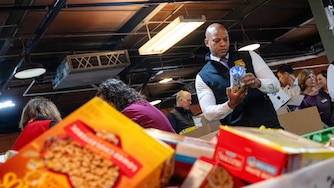At approximately 3 p.m., skies began to darken as the moon moved in front of the sun. Parents and young kids donned their multicolored glasses. The Maryland Science Center at Baltimore’s Inner Harbor buzzed with excitement as live streams from telescopes were shown throughout three levels of exhibits, the center’s planetarium and observatory.
Applause and whooping rang out as the moon partially eclipsed the sun. Using special black solar filters, which block out 99% of light, viewers had a safe way view the eclipse.
Observatory Coordinator Alexander Schmidt said the technology at the science center gave locals the chance to see it magnified over 100 times, even though they weren’t in the path of totality. Baltimore only saw 80% to 90% of the sun blocked by the moon.
“We wanted to be the cool resource to have here in the middle of Baltimore ... And so it’s a really good place for education and for a lot of people to see the eclipse from a full dome, instead their own places like a backyard,” Schmidt said.
Katie Elledge brought her daughter, Rosemary, 6, to see the eclipse at the science center.
“I think the most important way to learn is through experiences. When there’s something as exciting as a solar eclipse, you want them to experience it,” Elledge said.
The Maryland Science Center offered hands-on activities to teach kids about pinhole viewers and magnetic poles. Vinesha Hamilton brought her children, Sabella, 9, Zoey, 8 and Nila, 7, whom she home-schools.
“They literally get to put their hands on and talk to experts on what the eclipse is. You get to come look at the exhibits and touch instead of being in the house,” Hamilton said.
Sam Grinstead and his daughter, Nova, live in Columbia, but they regularly make their way to the science center. While on the rooftop, they looked up and smiled during the moon’s peak coverage time. They also caught a glimpse from the observatory.
“They had couple of pinhole-type viewers and then they had a telescope that had a projector on the back that projected the image, and you could actually see the surface of the sun — like, the complexity there and everything — that was pretty neat,” Grinstead said.
Grinstead said he was at work during the last eclipse. He and his coworkers and had to walk out in between buildings, passing around a few sets of glasses. The science center experience was better, he said.
“Everyone here had their own glasses and they had lots of informative experiments in there,” Grinstead said.
The next coast to coast total solar eclipse in the US will occur in 2045. The path of totality will arc over states along the West Coast and in the South, with a partial eclipse visible across other states.
Correction: This story has been updated to correct a quote from Sam Grinstead and to note that the event is a solar eclipse in the story’s caption.






Comments
Welcome to The Banner's subscriber-only commenting community. Please review our community guidelines.